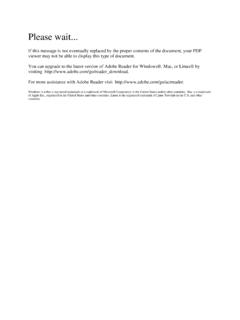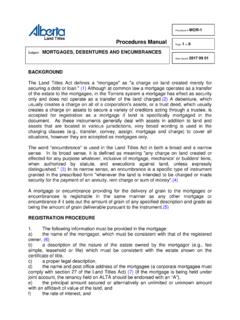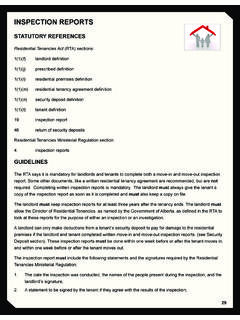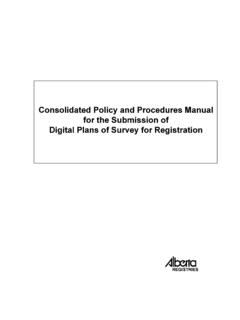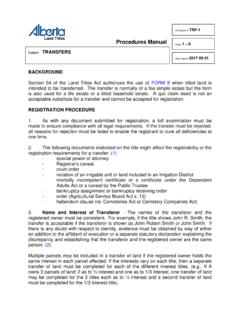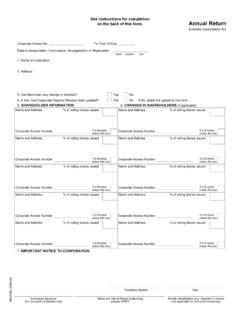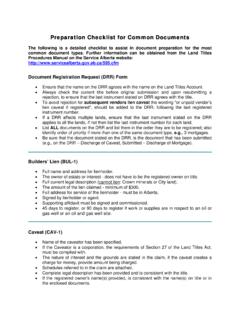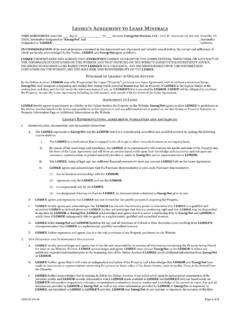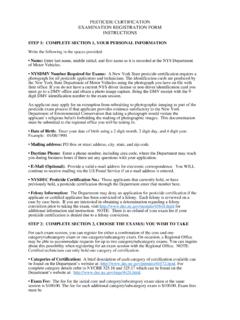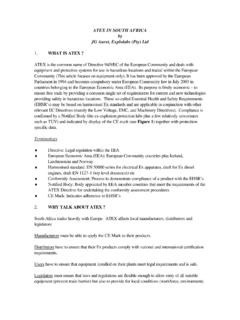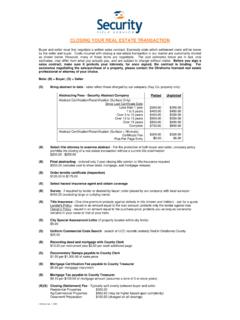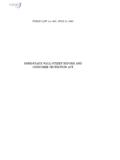Transcription of An Introduction to Alberta Land Titles
1 An Introduction to Alberta land Titles Index Page land Titles Organization and Purpose .. 3 The Settlement of Alberta .. 4 Basic Surveys in Alberta .. 5 Surface Rights and Mineral Rights .. 10 land Law and land Ownership in Alberta .. 11 land Conveyancing Systems .. 12 title Creation .. 13 Registration 17 Searches and Other Services .. 20 Summary .. 22 Glossary of Common Conveyancing Terms.
2 23 2 land Titles Organization and Purpose The land Titles Office, comprised of the Document examination and Surveys Sections, is part of the Registries & Consumer Services Division of Alberta Government Services. The Assistant Deputy Minister is the official Registrar for the land Titles Office, but day to day operations are managed within the land Titles Office by the Executive Director and Directors. Alberta has two land Titles Offices, one located in Edmonton (head office) and the other in Calgary, but function as one operation. The land registration system used in Alberta is based on the Torrens System of land registration and operates under the legislative authority of the land Titles Act.
3 Under this system, the Government has custody of all original Titles , documents and plans and has the legal responsibility for the validity and security of all registered land title information. The Government guarantees the accuracy of the title through the internal application and enforcement of laws derived from a multitude of statutes and court decisions. As a result, anyone who suffers a loss due to an error on the title or even as a result of a fraudulent transaction may take steps to obtain compensation from the government through the operation of the Assurance Fund. As a core Government business, land Titles provides an environment that ensures excellence in delivery of registration and information services to Albertans.
4 Qualified staff in offices located in Calgary and Edmonton review over 160 different types of documents and plans. Working in a quasi-judicial environment, staff examines legal documents and plans to ensure they comply with all current legislation (in excess of 100 statutes), case law and policies and procedures before accepting them for registration. All registered plans, Titles , and documents are available to be searched by the public, for a fee. The land Titles system in Alberta has been automated since 1988, when the ALTA ( Alberta land Titles Automation) system was implemented. All current Titles , as well as all Titles that have been electronically cancelled on the ALTA system, are maintained in electronic register form.
5 The contents of that register represent the legal, guaranteed title at all times. In 1999, the Surveys registration system was converted to a totally electronic system, including electronic submission, examination , registration, storage and dissemination of all survey plans in the province (over 250,000 plans). Survey plans, survey control marker data, original township plans, and a wide variety of other land related information are now delivered via a web-enabled Spatial Information System (SPIN) ( ). SPIN allows either parameter-based searches, or graphic, map-based searches of the plan and other land databases. This system provides access seven days a week 365 days a year to materials from anywhere the web can be accessed.
6 3 Plans are in place to re-engineer and replatform the core ALTA registration system onto current, more flexible and cost effective technology. A future business vision has been prepared, in conjunction with stakeholders, to identify the expectations of the re-engineered system ( ). The Settlement of Alberta In 1670, King Charles II of England granted a charter to the Hudson s Bay Company, giving it extensive rights to ownership, trading and government in Rupert s land . Rupert s land extended from east of Winnipeg to the Rocky Mountains. In 1867, the Dominion of Canada was formed, and in 1870 the Company surrendered its land to the Dominion. The land then became known as the Northwest Territories.
7 In exchange for the surrendered land , the Company was entitled to one-twentieth of the fertile belt (generally speaking, the area south of the North Saskatchewan River). The Dominion Government then arranged for the new Territories to be surveyed into four-sided (quadrilateral) townships. Each township contained 36 sections of approximately 640 acres (259 hectares) or one square mile each. The sections were further divided into quarter sections, each containing approximately 160 acres ( hectares). For its one-twentieth share, the Company usually chose section 8 and the southeast, southwest, and northwest quarters of section 26 from every township located in the fertile belt.
8 As townships were surveyed and the surveys were confirmed at Ottawa, the Company was sent Notifications (official lists of the land it was entitled to). The ownership of the listed land was transferred to the Company under the Dominion Lands Act, usually without any Patent documents being issued. To encourage settlement and railroad construction, the Dominion Crown (Government) also gave land to settlers and to railway companies. This was done by issuing patents or grants, which transferred ownership of land from the Crown to individuals or companies, thereby making it freehold land . Up to 1887, the Dominion Crown granted mineral rights with surface rights to land .
9 After that, limited grants for specific minerals were issued. In 1905, Alberta became a province and, in 1930, the power to grant both surface and mineral rights was transferred from the Dominion Government to the Government of Alberta . Alberta now leases but does not sell any of the mineral rights, which it owns. Surface rights to Crown lands, however, may be acquired from the province by application to the Department of Sustainable Resource Development. Crown land is conveyed from the province to the new owner by way of notification or transfer. 4 Basic Surveys in Alberta While some of Alberta is still unsurveyed, most of the completed surveying was done by the Third System of Township Surveys.
10 Under this system, land is first designated as being west of either the 4th meridian, 5th meridian or 6th meridian. These meridians are lines of longitude running north and south through Alberta . The 4th meridian forms the border between Alberta and Saskatchewan, the 5th meridian runs through Stony Plain and Calgary and the 6th meridian passes through Debolt and Jasper. Between the meridians are vertical columns called ranges, which are numbered in order from east to west of each meridian. Townships are horizontal rows crossing meridians and ranges. The row adjacent to the border is called township 1, the next row northward is township 2, and so on up to township 126 (the row adjacent to the Northwest Territories border).
